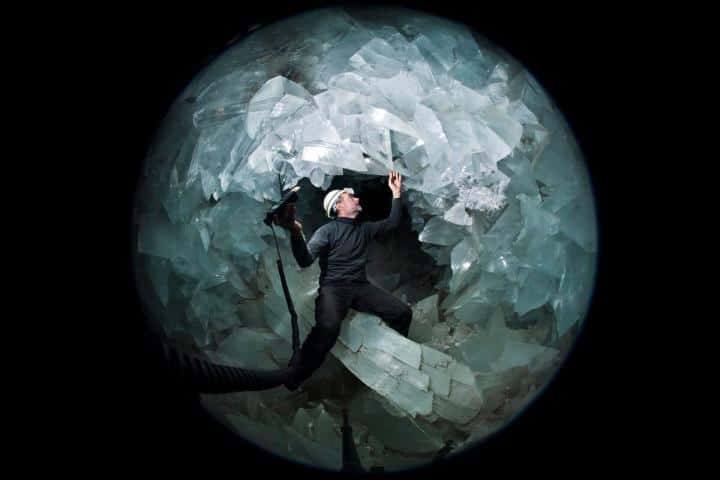The geode of Pulpí is an 11-meter hollow ovoid with crystal-paneled walls. It is like those familiar couplets of stone interiors covered with bright crystallites, but so large that several people can fit inside. The crystals, of up to two meters in size, are so transparent that they look like ice crystals. In this paper for Geology, Juan Manuel García-Ruiz and colleagues reveal the geological history that ended with the formation of the Pulpí geode.
Like the giant crystals of Naica in Mexico (see the 2007 Geology article by García-Ruiz and colleagues), the crystals of Pulpí are gypsum (calcium sulfate with two water molecules). García-Ruiz says, “To reveal their formation has been a very tough task because unlike in the case of Naica, where the hydrothermal system is still active, the large geode of Pulpí is a fossilized environment.”
The team performed a study of the geology and geochemistry of the abandoned mine where the geode was found, including a detailed mapping of the underground mining works, which has been used to allow the tourist visits in the mine.
They found that the crystals of Pulpi formed at around 20 °C, at a shallow depth where the temperature fluctuations of the climate are still perceptible. These temperature fluctuations, being below the maximum solubility of gypsum (40 °C), led to the dissolution and recrystallization amplifying a maturation process that is known as Ostwald maturation.
Says García-Ruiz, “This is somewhat like the temperature cycles in crystal quality control in industrial processes.” A continuous supply of salt for the formation of the crystals was provided by the dissolution of anhydrite (the anhydrous form of calcium sulfate), the mechanism accounting for the formation of the large crystals of Naica.
Because of their purity, the crystals forming the geode cannot be dated precisely. But indirect constraint can be done: “They grew for sure after the desiccation of the Mediterranean Sea that occurred 5.6 million years ago. They are most probably younger than two million years but older than 60.000 years because this is the age of the carbonate crust coating one of the large gypsum crystal,” says García-Ruiz.
If our reporting has informed or inspired you, please consider making a donation. Every contribution, no matter the size, empowers us to continue delivering accurate, engaging, and trustworthy science and medical news. Independent journalism requires time, effort, and resources—your support ensures we can keep uncovering the stories that matter most to you.
Join us in making knowledge accessible and impactful. Thank you for standing with us!

